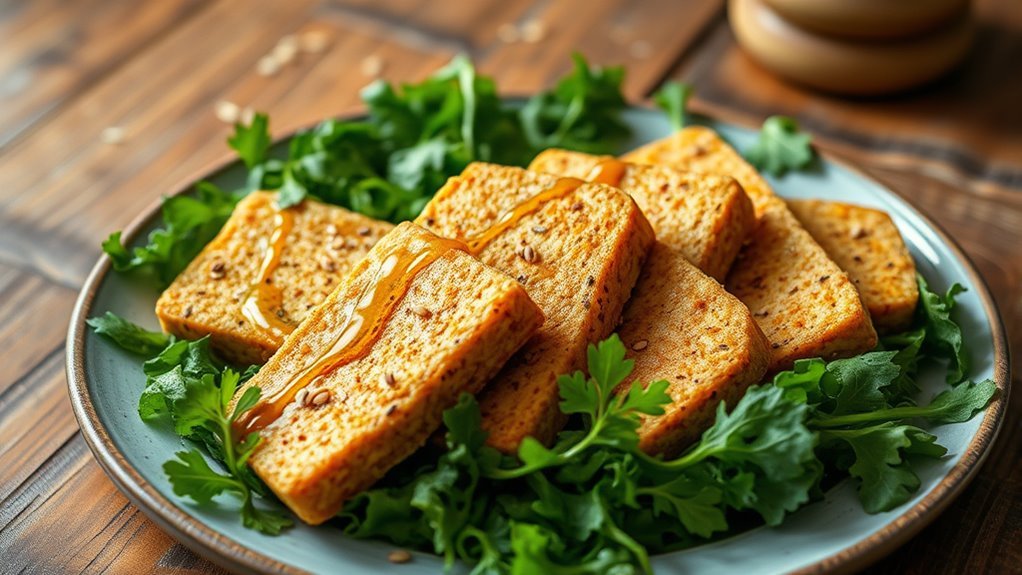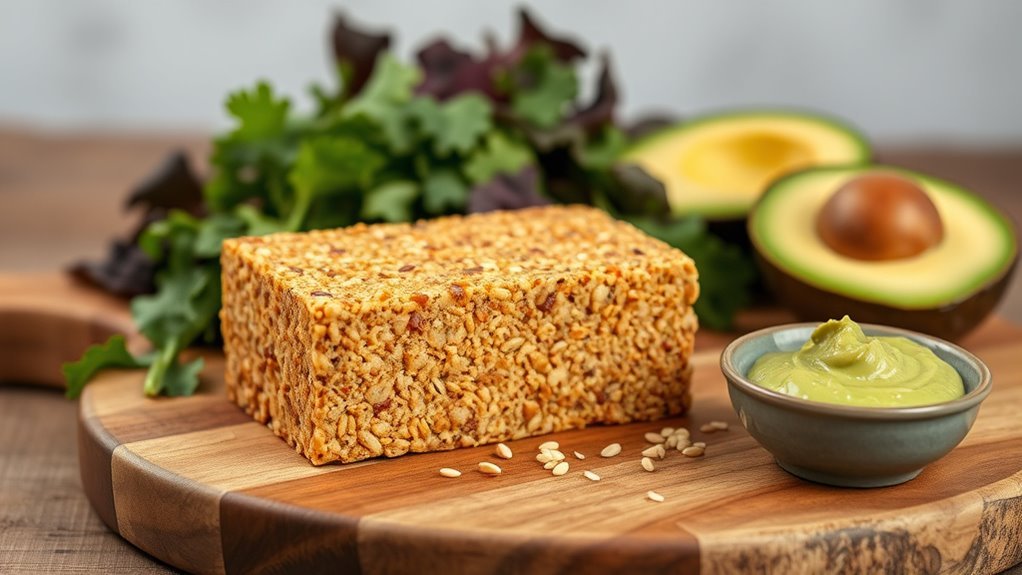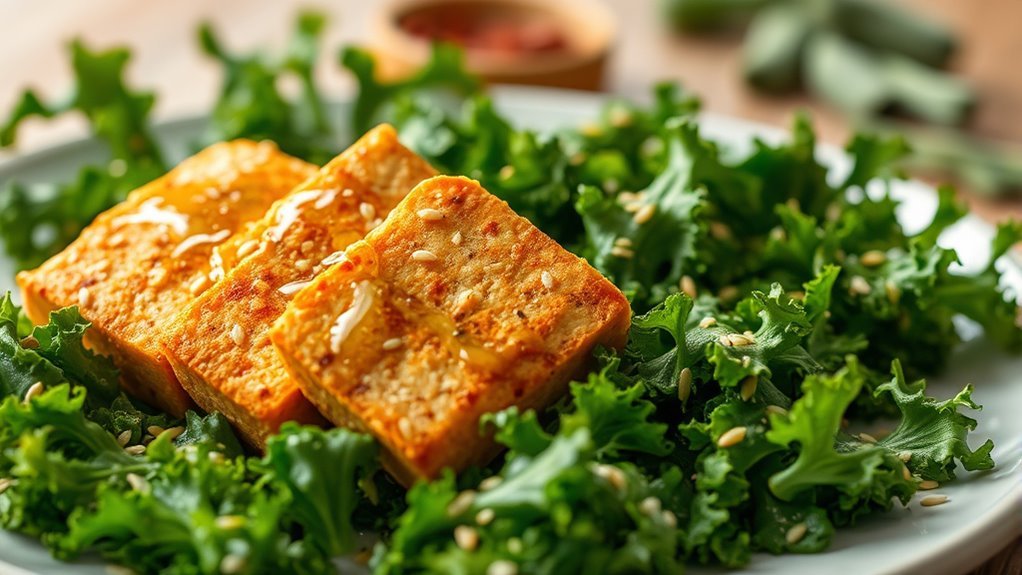Yes, tempeh is keto-friendly! It contains about 9 grams of carbs per 100 grams, making it a suitable choice for low-carb diets. Its high protein content, around 31 grams per cup, plus essential vitamins and minerals, supports overall health. Tempeh’s versatility allows you to prepare it in various ways while keeping it aligned with your ketogenic goals. If you’re curious about how to incorporate tempeh into your meals or explore its other benefits, there’s more to discover!
Understanding Tempeh and Its Nutritional Profile

When you think about plant-based protein sources, tempeh often comes to mind due to its rich nutritional profile. Originating from Indonesia, tempeh is made through a process called tempeh fermentation, where cooked soybeans are inoculated with a specific mold. This fermentation not only enhances its digestibility but also increases its protein content, making it an excellent choice for those seeking alternative protein sources. Tempeh is high in essential amino acids, fiber, and various vitamins and minerals, providing a well-rounded nutrient profile. Its unique texture and nutty flavor allow it to blend seamlessly into various dishes, giving you the freedom to explore different culinary creations. Understanding tempeh’s origins and benefits can empower you to incorporate it into a balanced diet.
Carbohydrate Content of Tempeh

Tempeh is a remarkable option for those monitoring their carbohydrate intake, especially within a ketogenic diet. With its low carb content, it can fit well into your meal plan. Here are some key points to take into account:
Tempeh is an excellent low-carb choice for ketogenic diets, making it a versatile addition to your meal plan.
- Carbohydrate Content: Tempeh typically contains around 9 grams of carbs per 100 grams, making it a suitable choice.
- Tempeh Preparation: Different cooking methods can slightly alter its carb content, so take into account steaming or sautéing for a keto-friendly dish.
- Tempeh Varieties: While traditional soy tempeh is popular, other varieties made from chickpeas or lentils may have different carb counts. Additionally, incorporating low-carb alternatives like leafy greens or non-starchy vegetables can enhance the overall nutritional profile of your meal.
Health Benefits of Tempeh

Tempeh is a nutrient-dense protein source, making it an excellent choice for those looking to boost their diet. It also supports gut health due to its probiotic content, promoting a balanced microbiome. Additionally, its low glycemic index means it won’t cause rapid spikes in blood sugar, making it suitable for a variety of dietary needs.
Nutrient-Dense Protein Source
As a powerhouse of nutrients, tempeh serves as an excellent protein source for those following a keto diet. This fermented soy product not only offers a robust protein content but also enhances your meals through various tempeh varieties and versatile tempeh preparation methods. Here’s why it’s such a fantastic choice:
- High protein content: Tempeh provides about 31 grams of protein per cup, making it a filling option.
- Rich in healthy fats: It contains beneficial fats, supporting your ketogenic goals.
- Packed with vitamins and minerals: Tempeh is a source of calcium, iron, and B vitamins, essential for overall health.
Incorporating tempeh into your meals can be both satisfying and nutritionally rewarding, offering freedom in your dietary choices.
Supports Gut Health
When considering foods that promote gut health, tempeh stands out due to its probiotic properties. This fermented soy product is rich in live cultures, which can enhance your gut microbiome. By incorporating tempeh into your diet, you could experience fermentation benefits that support digestion and improve nutrient absorption. Research suggests that a balanced gut microbiome is essential for overall health, aiding in immune function and even mental well-being. Tempeh’s fermentation process not only increases its digestibility but also contributes to the production of beneficial compounds, such as vitamins and enzymes. So, if you’re looking to support your gut health while enjoying a versatile and delicious food, tempeh is an excellent choice.
Low Glycemic Index
Because it has a low glycemic index, tempeh can be a smart addition to a ketogenic diet. This means it won’t cause significant spikes in your blood sugar, making it easier for you to manage your weight and maintain stable energy levels. Here are some benefits of incorporating tempeh into your meals:
- Sustained Energy: Low glycemic foods help provide steady energy without crashes.
- Weight Management: Tempeh’s low glycemic nature can aid in appetite control.
- Nutrient-Dense: It’s packed with protein and essential nutrients, making it a wholesome choice.
Tempeh’s Role in a Ketogenic Diet
While many people associate high-fat, low-carb foods with a ketogenic diet, tempeh can play a valuable role as a protein source. It’s a fermented soybean product that offers a substantial amount of protein while being relatively low in carbohydrates. When you consider tempeh preparation, you’ll find it versatile—grilling, sautéing, or baking can enhance its texture. Tempeh flavoring is equally important; marinating it with spices or sauces can elevate its taste, making it an appealing choice on a keto meal plan. Additionally, its rich nutrient profile, including fiber and essential amino acids, supports overall health. By incorporating tempeh thoughtfully, you can enjoy a satisfying, protein-rich food that aligns with your ketogenic goals while embracing culinary creativity.
How to Incorporate Tempeh Into Keto Meals
Incorporating tempeh into your keto meals can be both simple and delicious, as it serves as a versatile protein source that complements a variety of dishes. Here are some ideas to get you started:
- Stir-fry: Toss cubed tempeh in your favorite low-carb vegetables and sauces for a quick meal.
- Salads: Add marinated tempeh to salads for an extra protein boost, enhancing texture and flavor.
- Tempeh tacos: Use tempeh in lettuce wraps or low-carb tortillas for a satisfying taco night.
With these tempeh recipes, you can easily integrate it into your meal prep. Experiment with different spices and marinades to keep things exciting. Tempeh not only meets your protein needs but also aligns perfectly with your keto lifestyle. Enjoy the freedom of creativity in your cooking!
Tempeh vs. Other Protein Sources on Keto
When comparing tempeh to other protein sources on a keto diet, it becomes clear that tempeh offers unique benefits that can enhance your meal plan. Tempeh is a fermented soy product, providing not just protein but also probiotics, which can aid digestion. Unlike many animal proteins, tempeh is a plant-based option, making it a great alternative for those seeking protein alternatives. It’s low in carbs, fitting seamlessly into keto-friendly foods. Plus, with its firm texture, tempeh holds up well during meal prepping, absorbing flavors beautifully. While options like chicken or beef are popular, tempeh can diversify your protein intake, ensuring you enjoy a varied diet while sticking to your keto goals. Additionally, incorporating healthy fats from sources like olive oil and avocado oil can further enhance the nutritional profile of your tempeh dishes.
Tips for Choosing the Right Tempeh
Choosing the right tempeh can greatly enhance your keto meal plan, especially considering its unique attributes compared to other protein sources. Here are some tips to help you make the best choice:
- Explore tempeh varieties: Look for different types, like traditional soy or grain-based tempeh, which offer distinct flavor profiles and nutritional benefits.
- Consider cooking methods: Grilling, sautéing, or marinating can elevate the taste and texture, making tempeh more enjoyable.
- Check storage tips: Opt for tempeh that’s fresh and properly stored; it can last longer in the fridge, allowing you to enjoy it at your convenience.
Frequently Asked Questions
Can I Eat Tempeh Raw or Undercooked?
You shouldn’t eat raw or undercooked tempeh due to raw tempeh safety concerns. While tempeh is fermented, it’s best to cook it to eliminate any potential bacteria and enhance digestibility. Popular tempeh preparation methods include steaming, sautéing, or baking, which also improve its flavor and texture. Cooking not only makes it safer but also allows the nutrients to be better absorbed. Enjoy your tempeh cooked for both safety and taste!
Does Tempeh Contain Gluten?
Tempeh itself is naturally gluten-free, making it a great option for those with gluten sensitivity. Imagine you’re enjoying a delicious stir-fry packed with colorful veggies and tempeh; you don’t have to worry about gluten sneaking in. However, always check labels, as some brands may add gluten-containing ingredients. With its rich tempeh nutrition profile, you get protein and fiber without the gluten hassle, allowing you to enjoy your meal freely and safely.
Is Tempeh Suitable for Vegans?
Yes, tempeh’s definitely suitable for vegans! It’s made from fermented soybeans and packed with tempeh nutrition, providing protein, fiber, and essential nutrients. You can easily incorporate it into your meals with various tempeh recipes, whether you’re grilling, stir-frying, or adding it to salads. Its versatility means you can enjoy it in many dishes while sticking to a plant-based lifestyle. So go ahead, explore all the delicious options tempeh offers!
Can Tempeh Spoil Quickly?
Tempeh’s like a fleeting summer breeze; it can spoil if you don’t heed its needs. Typically, tempeh has a shelf life of about a week when refrigerated, but proper storage can extend its freshness. Keep it sealed in its original packaging or an airtight container to preserve its quality. If you notice any off smells or discoloration, it’s best to let go, embracing the freedom of fresh ingredients for your meals.
How Should I Store Leftover Tempeh?
To store leftover tempeh properly, place it in an airtight container in the refrigerator. It can last up to a week this way. If you want to extend its shelf life, consider freezing it. You can use thawed tempeh in various leftover recipes, like stir-fries or salads. Just remember to keep it sealed to prevent moisture and bacteria from spoiling your delicious leftovers. Enjoy your tempeh creations without worry!


